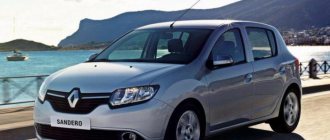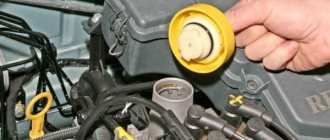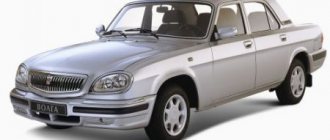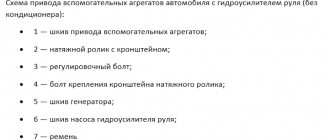The cost of gasoline is constantly rising. Therefore, the fuel consumption indicator for the Sandero plays a primary role when choosing a car. Fuel consumption varies depending on the modification of the hatchback. This indicator is influenced by the size of the installed engine and the type of transmission. In addition, the efficiency of the car is determined by the nature of driving. In particular, aggressive behavior on the road, which involves frequent acceleration and sudden braking, increases fuel consumption.
General consumption information
Renault Sandero comes with 4 petrol engines:
- 1.2 liters;
- 1.4 liters;
- 1.6 liters;
- 2 liters.
As Sandero's engine capacity increases, fuel consumption increases. However, not only this factor affects how quickly fuel is consumed. This indicator depends on:
- fuel system condition;
- driving habits;
- type of installed gearbox (Sandero uses manual and automatic);
- fuel quality;
- chassis condition;
- tire pressure and other factors.
Chip tuning allows you to reduce fuel consumption on Sandero. This procedure involves reconfiguring the electronic engine control unit.
The second nuance that must be taken into account when purchasing Sandero is that the manufacturer indicates average fuel consumption data. This indicator is calculated as part of tests carried out in certain, artificially created conditions. On public roads, fuel consumption on the Sandero can either increase or decrease. In particular, the indicator increases if the driver actively uses on-board electronics (air conditioning, audio system, etc.).
- Following these recommendations will help reduce gasoline consumption on your Sandero:
- adhere to an economical driving style that includes smooth acceleration and braking;
- fill up with gasoline at proven gas stations.
According to the technical documentation, the manufacturer recommends using AI-95 gasoline on the Sandero. But, as practice shows, the efficiency of hatchback engines and components does not decrease if the driver fills with fuel with an octane rating of 92.
Fuel consumption for Renault Sandero Stepway
Fuel consumption is one of the important factors that you definitely pay attention to when buying a car. After all, if the engine of your four-wheeled friend consumes an excessive amount of gasoline, then to “feed” it you need to have the corresponding income.
In today’s article we will talk about fuel consumption on the Renault Sandero Stepway and try to answer the question - why does the Stepway “eat” a little more gasoline than many cars with the same parameters?
In our article we will talk about fuel consumption in relation to an already run-in car with sufficient mileage, since during the run-in period of a newly purchased Stepway, gasoline consumption may increase, and significantly, especially during short city trips (home-shop-home).
In general, when you get acquainted with the stated characteristics of the Stepway, you expect quite economical gas mileage from this car. Take, for example, a car with an eight-valve engine of 1.6 and 84 hp. How much fuel should such a car consume? It doesn't seem like too much. In fact, Stepway with such characteristics consumes 10-11 liters per hundred in city mode and about 8 on the highway.
Let's face it - a significant number of cars with similar technical characteristics have an order of magnitude lower fuel consumption.
But why does Stepway get more gas mileage than potential buyers expect?
Numerous owners of this wonderful car, both the first and second series, have come to the conclusion that the answer to this question lies... in the gearbox. Or rather, in its gear ratios and, as a consequence, the intensity of engine speed at one speed or another. In Stepway, as conceived by its designers, the gearbox ratios are selected in such a way that the car’s engine “produces” increased speed, which leads to increased fuel consumption.
If we take an eight-valve Stepway with a 1.6 engine displacement on a manual and drive it along the highway, we will see that in 5th gear at a speed of 110 km/h the engine spins at a speed of more than 3000 rpm. In fourth gear at the same speed, the tachometer needle approaches 4000 rpm. And when overtaking, which on Stepway with a manual transmission in most cases has to be done in 4th gear, when the speed reaches 120-140 km/h, the engine spins at a speed of 5000 rpm and higher.
In general, Stepway’s engine speeds are somewhat high, and this applies not only to eight-valve engines. Of course, this state of affairs cannot but affect fuel consumption.
In conclusion, I would like to share my opinion regarding attempts to reduce gasoline consumption on Stepway by changing driving style, firmware, changing the brand of gasoline, etc.
As practice shows, all this is of little use. The only more or less effective way to slightly reduce fuel consumption on Stepway is to use a gentle driving mode, without spinning the engine to too high speeds. But how many of us are ready to drive in this manner? And to tell the truth, driving Stepan along the highway without revving the engine means forgetting about overtaking and trailing behind some truck all the way. More or less dynamic driving on Stepway, especially in track mode, requires turning the engine. No options.
As a result, having tried dozens of different ways to reduce fuel consumption on your car, you eventually state that your Stepway, as it ate an average of 10 liters per hundred, continues to eat them. This will calm your soul and you will pour into the machine as much as it asks. Tested for myself.
That's all, good luck on the roads and take care of yourself!
Engine 1.2
The 1.2-liter engine is installed on the second generation Renault Sandero. The French hatchback in this version is characterized by good efficiency, and therefore the car was often purchased for use in urban environments.
The 1.2-liter power unit has quite a lot of power. The engine output is 75 hp. Complete with this engine, the Sandero is equipped with a 5-speed manual transmission.
According to the technical documentation, the French hatchback in this version shows the following gasoline consumption (after covering 100 km):
- urban conditions - 7.7 l;
- driving on the highway - 5.1 l;
- mixed driving cycle - 6 l.
Some sources provide other information about the fuel consumption of Sandero in this modification, differing from those presented by no more than 0.1 liters.
Engine 1.4
The 1.4-liter engine was also installed on the first generation Renault Sandero. The engine, like the previous one, was equipped with a non-alternative 5-speed manual transmission. But due to the fact that the volume of the power unit is larger in this version of the Renault Sandero, the fuel consumption, all other things being equal (type of driving, quality of gasoline, etc.), is higher for the hatchback.
From the technical documentation it follows that a French hatchback with a 1.4-liter engine consumes an average of 9.2 liters of fuel every 100 km when driving around the city. Outside metropolitan areas, when traveling on highways, gasoline consumption decreases to 5.5 liters. In the mixed driving cycle, this figure reaches 6.8 liters.
When comparing the two Renault Sandero modifications given above, the version with a 1.2-liter engine will be more economical, but less dynamic. Acceleration to 100 km/h for a hatchback in this version takes about 14.5 seconds, while a car in modification with a 1.4-liter engine reaches this figure in 13 seconds.
Second generation car
The manufacturing company never stands still, and 3 years later, in 2014, it released the modernized Renault Sandero Stepway. Consumers saw the new look of the car, and also appreciated the newest line of engines, including the addition of an automatic transmission. Both presented power plants promised numerous potential buyers relatively low fuel consumption, and they could, as before, be filled with 92nd or, even better, 95th gasoline. The most modest version of the engine has 8 valves and the power is 82 l/hp. Fuel consumption on city streets is 9.5 liters. With a mixed driving cycle, the same figure is a good result - 7.2 liters, and already driving on the highway consumes only 5.9 liters of fuel.
The second, more serious and powerful version of the engine with 16 valves has a power of 102 l/hp. Gasoline consumption is:
- — on city streets 9.4 l;
- — in mixed mode 7.1 l;
- — on the highway outside the city 5.8 liters.
These indicators on a manual transmission, and accordingly on an automatic transmission the indicators given above, will certainly increase at least, although not by much, but by 0.3 liters.
In practice, it has been proven that with an automatic transmission, Renault consumes more fuel. The transmission has 4 stages, as opposed to 5 on the manual.
However, driving the car at a moderate and not sharp speed in the highest gear helps reduce fuel consumption and achieve, if possible, acceptable, more economical performance.
Conclusion
The car from Renault has a rather modest “appetite”, it has good dynamics and reliable 1.6 and 2.0 engines. If you refuel, as mentioned above, at trusted gas stations and use high-quality fuel, this will help achieve efficiency and allow the driver to enjoy driving.
Engine 1.6
1.6 liter engines were installed on Renault Sandero of both generations. Moreover, in the first generation models, an 8-valve unit was used, equipped with a 5-speed manual transmission, and the second – a 16-valve unit with an automatic transmission.
The “younger” generation of Sandero, equipped with an 84-horsepower engine, consumes an average of 10 fuel every 100 km when driving around the city. On the highway this figure drops to 5.8 liters. In mixed driving mode, the gasoline consumption of a hatchback with an 8-valve engine reaches 7.2 liters.
The first generation Sandero, modified with a 16-valve engine, consumes less fuel. The change in figure is partly due to the fact that this engine develops about 102 hp. power at 84 hp for a unit with eight valves. Fuel consumption when driving around the city is on average 9.4 liters. When exiting the highway, the figure drops to 5.8 liters. In mixed mode, the engine consumes about 7.1 liters.
A hatchback with a similar power plant, but with an automatic transmission, consumes about the same amount of gasoline. In the city this figure reaches 9.2 liters, on highways - 6.8 liters, and in mixed mode - 7 liters.
The 2021 Renault Sandero Stepway (second generation) with an 8-valve 1.6-liter unit and manual transmission demonstrates similar performance. In urban conditions, the fuel tank loses up to 9.8 liters of fuel every 100 km. Driving on the highway reduces gasoline reserves by 5.8 liters. In mixed driving mode, consumption reaches 7.2 liters.
As in the case of the first generation of the hatchback, installing a more powerful engine leads to increased efficiency of the car. In the city, fuel is consumed by 9.4 liters every 100 km. Outside the metropolis, the figure reaches 5.8 liters. And when driving in combined mode, the car consumes up to 7.1 liters.
Renault Sandero Stepway engines. Official fuel consumption per 100 km.
Generation 1 (2009-2014)
Gasoline engines:
- 1.6, 84 l. p., manual, front, consumption – 10.2/6.1 l per 100 km
- 1.6, 103 l. s., automatic, front, consumption – 12.1/6.6 l per 100 km.
Generation 2 (since 2013)
Gasoline engines:
- 1.6, 82 l. p., manual, front, consumption – 9.8/5.8 l per 100 km
- 1.6, 113 l. p., manual, front, consumption – 8.5/5.6 l per 100 km
- 1.6, 102 l. s., automatic, front, consumption – 10.9/6.6 l per 100 km.
Results
There are various modifications of the Renault Sandero Stepway on the market and on the roads, and the fuel consumption of cars of each generation is different. The most economical version, according to the technical documentation provided by the manufacturer, is considered to be the version with a 1.2-liter engine. However, this modification of the hatchback cannot boast of good dynamics and traction capabilities. In addition, the car in this version is equipped exclusively with a manual transmission, which creates certain difficulties when driving around the city.
The fuel consumption rate in both French cars and cars of other brands depends not only on the type of engine installed. The efficiency of transport is determined by driving style, the condition of the chassis and components, duration of operation and a number of other factors.
Reviews about Renault Sandero Stepway
A list of reviews from real car owners about the Renault Sandero Stepway, where they describe: operating experience, disadvantages and advantages (all pros and cons).
Friends, help is needed!
The car is only 3 months old, the mileage is about 3,000 km. After the next reset of the on-board computer, the average fuel consumption per 100 km is shown incorrectly. You drive 100 meters – it shows 55 l/100 km. You stand wound up in place, and the readings begin to increase.
I haven't applied for warranty yet.
What kind of glitch? I tried to reset the readings - everything was the same.
Renault Sandero Stepway 2 2021.
When you engage reverse gear, the lights do not light up and the rear wiper does not “wipe”. I tried to bridge the chip (the two lower contacts) - it didn’t light up. The sensor closes the two lower ones. I couldn't find the fuse.
Everything else seems to work, including the wipers and washers.
I like the Stepway machine, it works without problems. We've been driving it since 2017.
The battery died after 3.5 years. My husband put it on charge. Charged and turned on. But. Radio, CD - no sound. The sound does not turn on, all the programs from chanson and so on are displayed on the display, but there is no sound. In the menu you dial radio, enter the CODE, and then ERROR is displayed and that’s it. Maybe it needs to be reprogrammed.
Tell me, if anyone knows how to turn on the radio sound.
We took Renault Sandero Stepway (robot) in March.
At first everything is fine, it works great, I’m incredibly happy.
After a month the problems started:
• The first one was at the beginning of July, 2.4 thousand miles, we stopped in the middle of the city - the gears did not change, the display flashed between 2 and 3, we had difficulty getting to the parking lot. They picked it up on a tow truck, the service station said there was a small glitch, but nothing serious.
• After 20 days, we drove less than 100 km - again the same thing, revs up to 4 thousand, then it starts in second gear, and then it stopped shifting altogether. They picked it up again with a tow truck, this time they found some serious mistake, we will try to get the car replaced with a manual one.
I bought a Renault, 2021, when you turn on the air conditioner, the car stalls and doesn’t move.
The service center said to “press the gas harder,” but after the maintenance in April 2021, the car constantly stalls when accelerating - I give it the gas, but it doesn’t move... if you push it a little harder, it seems to accelerate with force.
Tell me, has anyone had this problem? and tell me what to do?
Good afternoon. I want to buy a Sandero Stepway-2 with a manual transmission and 82 hp. engine.
Please advise which alarm system is better to install?
At the dealership they said they were installing Scher-Khan Mobicar 2.
We purchased Sandero Stepway-2 two months ago. Transmission – manual, engine – 113 hp. The mileage is now 1700 km.
The troubles for me (as a driver with 33 years of experience) are:
1. Gearbox whine in first gear,
2. The windshield heating wires are very annoying when driving (especially at night), light refraction and all that. Personally, this causes eye strain and, as a result, headaches.
If anyone has the same problems and you know how to solve them, please answer.
I deliberately took the desperate step of buying a Stepway, I knew about all its (car name Stepan - male gender) shortcomings, but the main thing in a car is what you need and what your character is.
If you are going to drive like crazy and you have a lot of money, then this chat is not for you... Renault Stepway and Logan are cars that have been tested on the roads of Russia, they no longer feel like guests. Look around when you get to small towns - it’s all VAZs and Renaults - this is, in fact, a people’s car, but a foreign car. Everything that VAZ didn’t work out, Renault did.
Doors and hood, seats and trunk are the parts of the car that I pay the least attention to.










